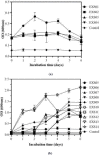Isolation, identification, and screening of biosurfactant-producing and hydrocarbon-degrading bacteria from oil and gas industrial waste
- PMID: 37388572
- PMCID: PMC10300049
- DOI: 10.1016/j.btre.2023.e00804
Isolation, identification, and screening of biosurfactant-producing and hydrocarbon-degrading bacteria from oil and gas industrial waste
Abstract
Qatar is one of the biggest oil and gas producers in the world, coupled with it is challenging environmental conditions (high average temperature: >40 °C, low annual rainfall: 46.71 mm, and high annual evaporation rate: 2200 mm) harbors diverse microbial communities that are novel and robust, with the potential to biodegrade hydrocarbons. In this study, we collected hydrocarbon contaminated sludge, wastewater and soil samples from oil and gas industries in Qatar. Twenty-six bacterial strains were isolated in the laboratory from these samples using high saline conditions and crude oil as the sole carbon source. A total of 15 different bacterial genera were identified in our study that have not been widely reported in the literature or studied for their usage in the biodegradation of hydrocarbons. Interestingly, some of the bacteria that were identified belonged to the same genus however, demonstrated variable growth rates and biosurfactant production. This indicates the possibility of niche specialization and specific evolution to acquire competitive traits for better survival. The most potent strain EXS14, identified as Marinobacter sp., showed the highest growth rate in the oil-containing medium as well as the highest biosurfactant production. When this strain was further tested for biodegradation of hydrocarbons, the results showed that it was able to degrade 90 to 100% of low and medium molecular weight hydrocarbons and 60 to 80% of high molecular weight (C35 to C50) hydrocarbons. This study offers many promising leads for future studies of microbial species and their application for the treatment of hydrocarbon contaminated wastewater and soil in the region and in other areas with similar environmental conditions.
Keywords: 16s rRNA; Biodegradation; Crude oil; Hydrocarbons; Marinobacter sp, Biosurfactant.
© 2023 ExxonMobil.
Conflict of interest statement
Authors declare that they have no competing conflict of interest.
Figures








Similar articles
-
Characterization of bacterial community in oil-contaminated soil and its biodegradation efficiency of high molecular weight (>C40) hydrocarbon.Chemosphere. 2022 Feb;289:133168. doi: 10.1016/j.chemosphere.2021.133168. Epub 2021 Dec 8. Chemosphere. 2022. PMID: 34890617
-
Isolation and characterization of Halomonas sp. strain C2SS100, a hydrocarbon-degrading bacterium under hypersaline conditions.J Appl Microbiol. 2009 Sep;107(3):785-94. doi: 10.1111/j.1365-2672.2009.04251.x. Epub 2009 Mar 23. J Appl Microbiol. 2009. PMID: 19320948
-
Characterization of Biosurfactant Produced during Degradation of Hydrocarbons Using Crude Oil As Sole Source of Carbon.Front Microbiol. 2017 Feb 22;8:279. doi: 10.3389/fmicb.2017.00279. eCollection 2017. Front Microbiol. 2017. PMID: 28275373 Free PMC article.
-
Simultaneous hydrocarbon biodegradation and biosurfactant production by oilfield-selected bacteria.J Appl Microbiol. 2011 Sep;111(3):525-36. doi: 10.1111/j.1365-2672.2011.05071.x. Epub 2011 Jul 4. J Appl Microbiol. 2011. PMID: 21668593
-
Screening biosurfactant-producing actinomycetes: Identification of Streptomyces sp. RP1 as a potent species for bioremediation.J Basic Microbiol. 2024 Apr;64(4):e2300585. doi: 10.1002/jobm.202300585. Epub 2024 Feb 12. J Basic Microbiol. 2024. PMID: 38346247
Cited by
-
Exploring the potential of biosurfactants produced by fungi found in soil contaminated with petrochemical wastes.Sci Rep. 2024 Oct 28;14(1):25733. doi: 10.1038/s41598-024-75865-5. Sci Rep. 2024. PMID: 39468200 Free PMC article.
-
Construction of Shale Gas Oil-Based Drilling Cuttings Degrading Bacterial Consortium and Their Degradation Characteristics.Microorganisms. 2024 Feb 2;12(2):318. doi: 10.3390/microorganisms12020318. Microorganisms. 2024. PMID: 38399720 Free PMC article.
-
Microbial communities in petroleum refinery effluents and their complex functions.Saudi J Biol Sci. 2024 Jul;31(7):104008. doi: 10.1016/j.sjbs.2024.104008. Epub 2024 May 6. Saudi J Biol Sci. 2024. PMID: 38766506 Free PMC article. Review.
-
Microbially derived surfactants: an ecofriendly, innovative, and effective approach for managing environmental contaminants.Front Bioeng Biotechnol. 2024 Aug 26;12:1398210. doi: 10.3389/fbioe.2024.1398210. eCollection 2024. Front Bioeng Biotechnol. 2024. PMID: 39253704 Free PMC article. Review.
References
-
- QNV 2030 Sustainability. Report. 2019 https://www.gco.gov.qa/en/about-qatar/national-vision2030/
-
- Eldos H.I., Khan M., Zouari N., Saeed S., Al-Ghouti M.A. Characterization and assessment of process water from oil and gas production: a case study of process wastewater in Qatar. Case Studies in. Chem. Environ. Eng. 2022;6 doi: 10.1016/j.cscee.2022.100210. - DOI
-
- Abdel-Shafy H.I., Mansour M.S. A review on polycyclic aromatic hydrocarbons: source, environmental impact, effect on human health and remediation. Egyp. J. Petrol. 2016;25(1):107–123. doi: 10.1016/j.ejpe.2015.03.011. - DOI
-
- Eldos H.I., Ashfaq M.Y., Al-Ghouti M.A. Rapid assessment of the impact of microwave heating coupled with UV-C radiation on the degradation of PAHs from contaminated soil using FTIR and multivariate analysis. Arab. J. Chem. 2020;13(11):7609–7625. doi: 10.1016/j.arabjc.2020.08.031. - DOI
-
- Hamoudi-Belarbi L., Hamoudi S., Belkacemi K., Nouri L., Bendifallah L., Khodja M. Bioremediation of polluted soil sites with crude oil hydrocarbons using carrot peel waste. Environments. 2018;5(11):124. doi: 10.3390/environments5110124. - DOI
LinkOut - more resources
Full Text Sources
